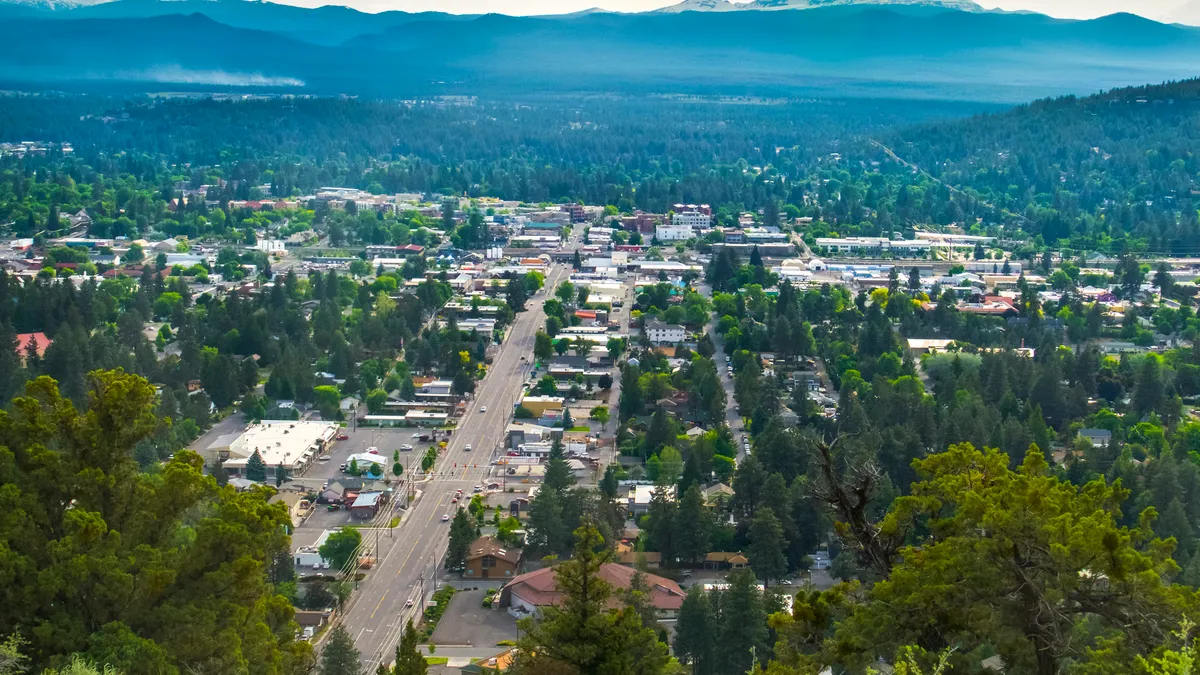A sizable chunk of people throughout the U.S. who have disconnected their jobs from their physical locations during the pandemic are moving away from large metro areas to mid-size and smaller cities.
“Once you have people disconnecting their jobs from their locations, it gives them a lot of flexibility in where they live,” said Peter Haslag, assistant professor of finance at Vanderbilt University.
More than 12% of moves between April 2020 and December 2021 were influenced by COVID-19, with a significant shift toward smaller cities that offer a lower cost of living, lower taxes and fewer pandemic-related restrictions, according to a report released last month that Haslag co-authored.
Analyzing 360,000 residential, interstate moves from the past five years, 70% of those citing remote work as the reason for their move earn more than $100,000 annually.
To be sure, the “superstar geography dominated by huge coastal metro areas” is not going away, said Mark Muro, a senior fellow with the Brookings Institute. However, some regions, like the Bay Area, are seeing enough of an exodus to impact their tax base, he said.
Between 2010 and 2019, the tech sector grew by 47% and added 1.2 million jobs, with about half the job creation occurring in eight areas:
- San Francisco
- San Jose, California
- Austin, Texas
- Boston
- Seattle
- Los Angeles
- New York City
- The Washington, D.C area.
In addition, some mid-sized cities added tech jobs at a rate of 3% or more annually, including Atlanta, Dallas, and Kansas City, Missouri, according to the Brookings Institute.
That shifted during the pandemic, according to Brookings, when technology-related job growth in these areas slowed while accelerating in about half of other metro areas, including Philadelphia, Minneapolis, Minnesota, Cincinnati, Ohio, and Nashville, Tennessee.
Growth also was notable in university cities like Madison, Wisconsin and lifestyle areas like Pensacola, Florida, Brookings noted. The data points to “modest tech sector decentralization during the pandemic,” Brookings wrote.
Still, housing prices in the areas that have experienced some out-migration will likely drop a bit, making these cities more affordable. That should attract new residents. “I don’t think New York City will die,” Haslag said.
Yet, multiple smaller metro areas are seeing population growth. Moreover, those moving to these areas are likely to remain there long term, as many are mid-career and raising families, Haslag said.
Managing growth
About 100,000 people now call the Bend, Oregon home, up from more than 70,000 in 2011, said Russell Grayson, chief operations officer. “When we got out of the recession, we took off like a rocket ship.”
While it’s difficult to pin down the percentage of remote workers, Ben Hemson, who works in city government as business advocate for Bend, estimated it’s between 12% and 15% of the workforce.
Some new residents also are bringing businesses that can operate anywhere, helping to diversify the business sector, he said. Coming out of the recession, a large portion of Bend’s economy focused on real estate development. Now, there’s a burgeoning tech sector, along with an outdoor products industry, he added.
The growth has also brought challenges. Between the first quarter of 2020 and the fourth quarter of 2021, the house price index for Bend jumped 40%. Traffic congestion and homelessness have also increased, Grayson said.
While new development broadens the tax base, much of the additional funding is going to fundamental services, like fire and police, which together account for about three-quarters of the general fund. “We’re not seeing enough growth in property tax to ramp up [spending on] transit, homeless services,” he added.
Meanwhile, Denver has grown by 112,000 people the last decade, many of them arriving from both coasts, said Principal City Planner David Gaspers. As in Bend, housing prices have jumped, rising about 33% between January 2020 and January 2022.
The Denver City Council will vote on an initiative to expand housing affordability in June. It would allow developers to add height to their projects when they include more affordable units than is required. It also increases the linkage fee that supports Denver’s affordable housing fund.
Over the past couple of decades, the city invested heavily in transit, using proceeds from a 2004 sales tax increase to create a vibrant area from what used to be desolate parking lots near Union Station downtown. “It’s a reimagined transit hub with offices and apartments,” Gaspers said.
As Denver has grown, so has the percentage of jobs in the area that are designated “innovative,” such as positions in technology and advanced manufacturing. In 2021, 56% of jobs were considered innovative, up from 52.6% in 2020. However, Gaspers noted the loss of service jobs at restaurants and similar businesses also influenced these numbers.
How sustained the migration to smaller cities will be is unknown. However, Haslag said his research indicates that more people are choosing to live outside cities more frequently than they did before the pandemic.
That holds promise for a wider range of vibrant cities. It will allow more cities to build their own technology industries and ecosystems, said Brooks Rainwater, director of the National League of Cities’ Center for City Solutions.
And, the cities from which tech workers are moving will need to “think of their downtowns in different ways,” Rainwater said. While the emphasis has been on filling downtown areas with companies that then bring along their workers, cities now will need to focus on their housing mix and drawing people for entertainment and meeting others.






















